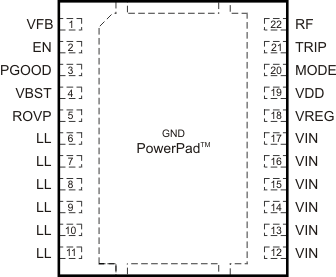ZHCS979F June 2012 – October 2020 TPS53318 , TPS53319
PRODUCTION DATA
- 1 特性
- 2 应用
- 3 说明
- 4 Revision History
- 5 Device Comparison Table
- 6 Pin Configuration and Functions
- 7 Specifications
-
8 Detailed Description
- 8.1 Overview
- 8.2 Functional Block Diagram
- 8.3
Feature Description
- 8.3.1 5-V LDO and VREG Start-Up
- 8.3.2 Adaptive On-Time D-CAP Control and Frequency Selection
- 8.3.3 Ramp Signal
- 8.3.4 Adaptive Zero Crossing
- 8.3.5 Output Discharge Control
- 8.3.6 Power-Good
- 8.3.7 Current Sense, Overcurrent, and Short Circuit Protection
- 8.3.8 Overvoltage and Undervoltage Protection
- 8.3.9 Redundant Overvoltage Protection (OVP)
- 8.3.10 UVLO Protection
- 8.3.11 Thermal Shutdown
- 8.3.12 Small Signal Model
- 8.3.13 External Component Selection Using All Ceramic Output Capacitors
- 8.4 Device Functional Modes
-
9 Application and Implementation
- 9.1 Application Information
- 9.2
Typical Applications
- 9.2.1
Application Using Bulk Output Capacitors, Redundant Overvoltage Protection Function (OVP) Disabled
- 9.2.1.1 Design Requirements
- 9.2.1.2
Detailed Design Procedure
- 9.2.1.2.1 Step One: Select Operation Mode and Soft-Start Time
- 9.2.1.2.2 Step Two: Select Switching Frequency
- 9.2.1.2.3 Step Three: Choose the Inductor
- 9.2.1.2.4 Step Four: Choose the Output Capacitor or Capacitors
- 9.2.1.2.5 Step Five: Determine the Value of R1 and R2
- 9.2.1.2.6 Step Six: Choose the Overcurrent Setting Resistor
- 9.2.1.3 Application Curves
- 9.2.2 Application Using Ceramic Output Capacitors, Redundant Overvoltage Protection Function (OVP) Enabled
- 9.2.1
Application Using Bulk Output Capacitors, Redundant Overvoltage Protection Function (OVP) Disabled
- 10Power Supply Recommendations
- 11Layout
- 12Device and Documentation Support
- 13Mechanical, Packaging, and Orderable Information
6 Pin Configuration and Functions
 Figure 6-1 22 Pins DQP (LSON-CLIP)
Package (Top View)
Figure 6-1 22 Pins DQP (LSON-CLIP)
Package (Top View)Table 6-1 Pin Functions
| PIN | I/O/P(1) | DESCRIPTION | ||
|---|---|---|---|---|
| NAME | NO. | |||
| EN | 2 | I | Enable pin. Typical turnon threshold voltage is 1.3 V. Typical turnoff threshold voltage is 1.0 V. | |
| GND | G | Ground and thermal pad of the device. Use proper number of vias to connect to ground plane. | ||
| LL | 6 | B | Output of converted power. Connect this pin to the output inductor. | |
| 7 | ||||
| 8 | ||||
| 9 | ||||
| 10 | ||||
| 11 | ||||
| MODE | 20 | I | Soft start and mode selection. Connect a resistor to select soft-start time using Table 8-3. The soft-start time is detected and stored into internal register during start-up. | |
| PGOOD | 3 | O | Open drain power-good flag. Provides 1-ms start-up delay after VFB falls in specified limits. When VFB goes out of the specified limits, PGOOD goes low after a 2-µs delay. | |
| ROVP | 5 | I | Redundant overvoltage protection (OVP) input. Use a resistor divider to connect this pin to VOUT. Internally pulled down to GND with a 1.5-MΩ resistor. If redundant OVP is not needed, connect this pin to GND. Do not leave ROVP pin floating (see Section 8.3.9). | |
| RF | 22 | I | Switching frequency selection. Connect a resistor to GND or VREG to select switching frequency using Table 8-1. The switching frequency is detected and stored during the start-up. | |
| TRIP | 21 | I | OCL detection threshold setting pin. ITRIP = 10 µA at room temperature. 3000 ppm/°C current is sourced and set the OCL trip voltage as follows. | |
| VOCL = VTRIP/32 | (VTRIP ≤ 2.4 V, VOCL ≤ 75 mV) | |||
| VBST | 4 | P | Supply input for high-side FET gate driver (boost terminal). Connect capacitor from this pin to LL node. Internally connected to VREG via bootstrap MOSFET switch. | |
| VDD | 19 | P | Controller power supply input. VDD input voltage range is from 4.5 V to 25 V. | |
| VFB | 1 | I | Output feedback input. Connect this pin to VOUT through a resistor divider. | |
| VIN | 12 | P | Conversion power input. The conversion input voltage range is from 1.5 V to 22 V. | |
| 13 | ||||
| 14 | ||||
| 15 | ||||
| 16 | ||||
| 17 | ||||
| VREG | 18 | P | 5-V low dropout (LDO) output. Supplies the internal analog circuitry and driver circuitry. | |
| Thermal Pad | G | Ground and thermal pad of the device. Use a proper number of vias to connect to ground plane. | ||
(1) I = Input, O = Output, B = Bidirectional, P = Supply, G =
Ground